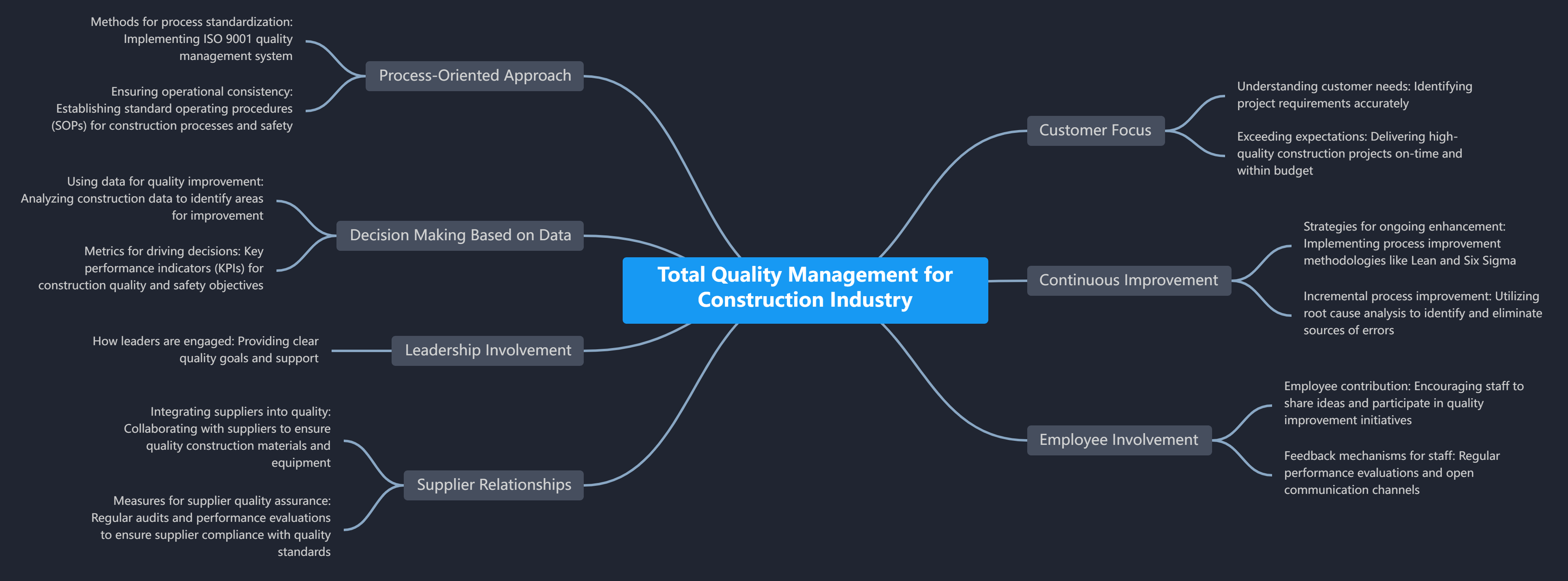
Description of the Mind Map Content
This mind map outlines the principles and components of Total Quality Management (TQM) specifically tailored for the construction industry. The key areas covered in the mind map include:
- Process-Oriented Approach:
- Methods for process standardization: Implementing ISO 9001 quality management system.
- Ensuring operational consistency: Establishing standard operating procedures (SOPs) for construction processes and safety.
- Customer Focus:
- Understanding customer needs: Identifying project requirements accurately.
- Exceeding expectations: Delivering high-quality construction projects on-time and within budget.
- Decision Making Based on Data:
- Using data for quality improvement: Analyzing construction data to identify areas for improvement.
- Metrics for driving decisions: Key performance indicators (KPIs) for construction quality and safety objectives.
- Continuous Improvement:
- Strategies for ongoing enhancement: Implementing process improvement methodologies like Lean and Six Sigma.
- Incremental process improvement: Utilizing root cause analysis to identify and eliminate sources of errors.
- Leadership Involvement:
- How leaders are engaged: Providing clear quality goals and support.
- Employee Involvement:
- Employee contribution: Encouraging staff to share ideas and participate in quality improvement initiatives.
- Feedback mechanisms for staff: Regular performance evaluations and open communication channels.
- Supplier Relationships:
- Integrating suppliers into quality: Collaborating with suppliers to ensure quality construction materials and equipment.
- Measures for supplier quality assurance: Regular audits and performance evaluations to ensure supplier compliance with quality standards.
Insights from the Mind Map
- The construction industry can benefit significantly from a process-oriented approach, involving the standardization of processes and the implementation of quality management systems.
- Customer satisfaction is a priority, and achieving it involves accurately identifying and exceeding project requirements.
- Data-driven decision-making is emphasized, with a focus on analyzing construction data and using key performance indicators for quality and safety objectives.
- Continuous improvement is a core principle, with strategies such as Lean, Six Sigma, and root cause analysis for ongoing enhancement.
- Leadership and employee involvement are crucial for the success of TQM, emphasizing clear goals, support, and engagement.
- Building strong relationships with suppliers and integrating them into quality processes through collaboration, audits, and evaluations is essential for ensuring high-quality construction materials and equipment.
Creating Mind Maps with Visual Paradigm Smart Board
Visual Paradigm Smart Board emerges as a comprehensive online mind map tool that facilitates effective collaboration in the construction industry. Serving as an adept mind map maker, this software provides a user-friendly platform for professionals to employ a process-oriented approach, implementing ISO 9001 standards and establishing standard operating procedures (SOPs) seamlessly. The tool’s capability to comprehend customer needs and surpass expectations aligns with the industry’s customer-focused demands. Decision-making grounded in data is supported through robust analytics features, utilizing key performance indicators (KPIs) for quality and safety objectives. Continuous improvement methodologies, including Lean and Six Sigma, find a natural home in Visual Paradigm Smart Board, ensuring ongoing enhancement and error elimination. The platform also promotes leadership and employee involvement, fostering a culture of quality. Moreover, its supplier relationship features guarantee the integration of suppliers into the quality assurance process through collaborative efforts, audits, and evaluations. As an online mind map software, Visual Paradigm Smart Board serves as an invaluable asset for construction professionals, fostering online brainstorming and providing a seamless brainstorming tool for enhanced project outcomes.